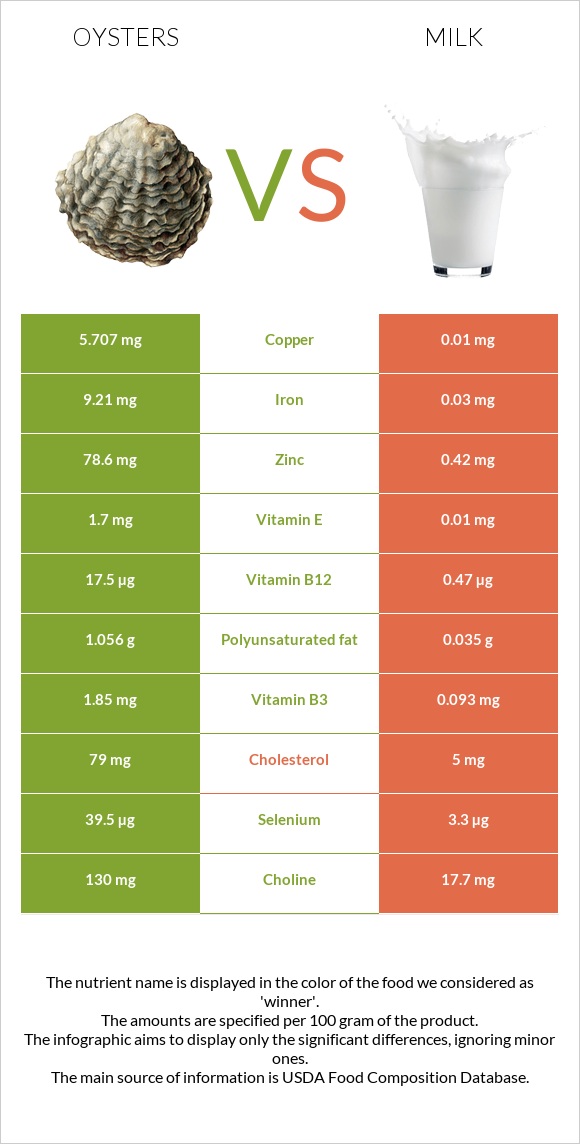Oysters vs. Milk — In-Depth Nutrition Comparison
Compare
Differences between oysters and milk
- Milk contains less zinc, vitamin B12, copper, iron, selenium, manganese, choline, phosphorus, and vitamin E than oysters.
- Oysters's daily need coverage for zinc is 711% higher.
- Milk contains 571 times less copper than oysters. Oysters contains 5.707mg of copper, while milk contains 0.01mg.
- The amount of cholesterol in milk is lower.
- Oysters has a lower glycemic index. The glycemic index of oysters is 0, while the glycemic index of milk is 31.
The food types used in this comparison are Mollusks, oyster, eastern, wild, cooked, moist heat and Milk, lowfat, fluid, 1% milkfat, with added vitamin A and vitamin D.
Infographic

Infographic link
Mineral Comparison
Mineral comparison score is based on the number of minerals by which one or the other food is richer. The "coverage" charts below show how much of the daily needs can be covered by 300 grams of the food.
| Contains more MagnesiumMagnesium | +218.2% |
| Contains more IronIron | +30600% |
| Contains more CopperCopper | +56970% |
| Contains more ZincZinc | +18614.3% |
| Contains more PhosphorusPhosphorus | +104.2% |
| Contains more ManganeseManganese | +19600% |
| Contains more SeleniumSelenium | +1097% |
| Contains less SodiumSodium | -73.5% |
Vitamin Comparison
Vitamin comparison score is based on the number of vitamins by which one or the other food is richer. The "coverage" charts below show how much of the daily needs can be covered by 300 grams of the food.
| Contains more Vitamin EVitamin E | +16900% |
| Contains more Vitamin B1Vitamin B1 | +80% |
| Contains more Vitamin B3Vitamin B3 | +1889.2% |
| Contains more Vitamin B5Vitamin B5 | +23.8% |
| Contains more Vitamin B6Vitamin B6 | +64.9% |
| Contains more Vitamin B12Vitamin B12 | +3623.4% |
| Contains more Vitamin KVitamin K | +1900% |
| Contains more FolateFolate | +180% |
| Contains more CholineCholine | +634.5% |
| Contains more Vitamin AVitamin A | +123.1% |
| Contains more Vitamin DVitamin D | +∞% |
All nutrients comparison - raw data values
| Nutrient |  |
 |
DV% diff. |
| Zinc | 78.6mg | 0.42mg | 711% |
| Vitamin B12 | 17.5µg | 0.47µg | 710% |
| Copper | 5.707mg | 0.01mg | 633% |
| Iron | 9.21mg | 0.03mg | 115% |
| Selenium | 39.5µg | 3.3µg | 66% |
| Manganese | 0.591mg | 0.003mg | 26% |
| Cholesterol | 79mg | 5mg | 25% |
| Choline | 130mg | 17.7mg | 20% |
| Protein | 11.42g | 3.37g | 16% |
| Phosphorus | 194mg | 95mg | 14% |
| Vitamin B3 | 1.85mg | 0.093mg | 11% |
| Vitamin E | 1.7mg | 0.01mg | 11% |
| Polyunsaturated fat | 1.056g | 0.035g | 7% |
| Vitamin D | 2 IU | 48 IU | 6% |
| Magnesium | 35mg | 11mg | 6% |
| Vitamin D | 0µg | 1.2µg | 6% |
| Sodium | 166mg | 44mg | 5% |
| Fats | 3.42g | 0.97g | 4% |
| Vitamin A | 26µg | 58µg | 4% |
| Calories | 102kcal | 42kcal | 3% |
| Vitamin K | 2µg | 0.1µg | 2% |
| Folate | 14µg | 5µg | 2% |
| Vitamin B5 | 0.447mg | 0.361mg | 2% |
| Vitamin B6 | 0.061mg | 0.037mg | 2% |
| Vitamin B1 | 0.036mg | 0.02mg | 1% |
| Calcium | 116mg | 125mg | 1% |
| Saturated fat | 0.948g | 0.633g | 1% |
| Monounsaturated fat | 0.506g | 0.277g | 1% |
| Carbs | 5.45g | 4.99g | 0% |
| Net carbs | 5.45g | 4.99g | N/A |
| Potassium | 139mg | 150mg | 0% |
| Sugar | 1.23g | 5.2g | N/A |
| Starch | 0.9g | 0% | |
| Vitamin B2 | 0.18mg | 0.185mg | 0% |
| Trans fat | 0.068g | N/A | |
| Tryptophan | 0.138mg | 0.043mg | 0% |
| Threonine | 0.046mg | 0.143mg | 0% |
| Isoleucine | 0.459mg | 0.174mg | 0% |
| Leucine | 0.716mg | 0.319mg | 0% |
| Lysine | 0.762mg | 0.282mg | 0% |
| Methionine | 0.257mg | 0.088mg | 0% |
| Phenylalanine | 0.413mg | 0.174mg | 0% |
| Valine | 0.523mg | 0.22mg | 0% |
| Histidine | 0.22mg | 0.101mg | 0% |
| Omega-3 - EPA | 0.353g | 0g | N/A |
| Omega-3 - DHA | 0.271g | 0g | N/A |
| Omega-3 - ALA | 0.163g | 0.004g | N/A |
| Omega-3 - DPA | 0.02g | 0g | N/A |
| Omega-3 - Eicosatrienoic acid | 0.004g | N/A | |
| Omega-6 - Gamma-linoleic acid | 0.004g | N/A | |
| Omega-6 - Dihomo-gamma-linoleic acid | 0.007g | N/A | |
| Omega-6 - Eicosadienoic acid | 0.007g | N/A | |
| Omega-6 - Linoleic acid | 0.061g | 0.027g | N/A |
Macronutrient Comparison
Macronutrient breakdown side-by-side comparison
| Contains more ProteinProtein | +238.9% |
| Contains more FatsFats | +252.6% |
| Contains more OtherOther | +102.7% |
| Contains more WaterWater | +15% |
~equal in
Carbs
~4.99g
Fat Type Comparison
Fat type breakdown side-by-side comparison
| Contains more Mono. FatMonounsaturated fat | +82.7% |
| Contains more Poly. FatPolyunsaturated fat | +2917.1% |
| Contains less Sat. FatSaturated fat | -33.2% |
Carbohydrate type comparison
Carbohydrate type breakdown side-by-side comparison
| Contains more StarchStarch | +∞% |
| Contains more GlucoseGlucose | +∞% |
| Contains more LactoseLactose | +∞% |
~equal in
Sucrose
~0g
~equal in
Fructose
~0g
~equal in
Maltose
~0g
~equal in
Galactose
~0g





